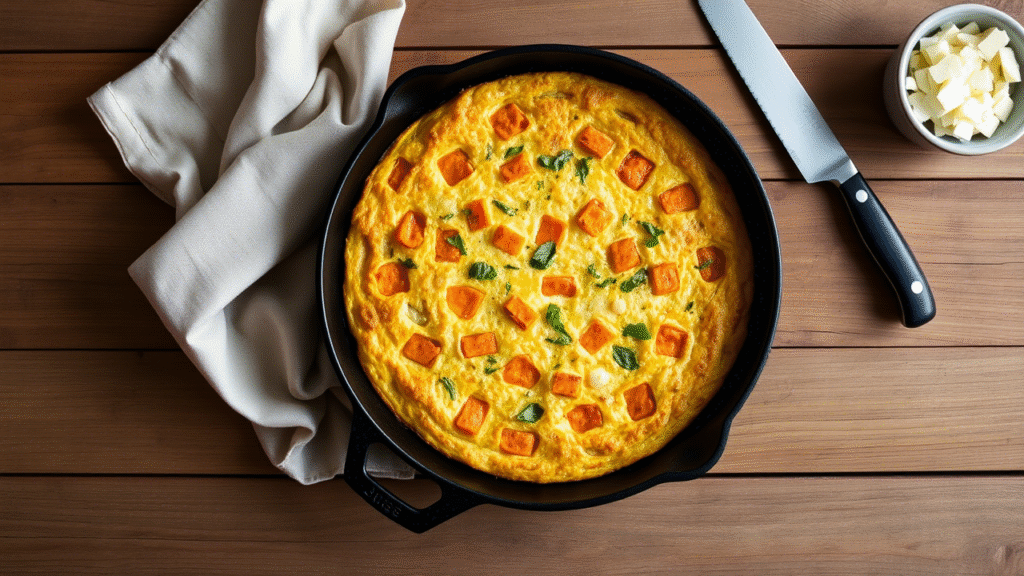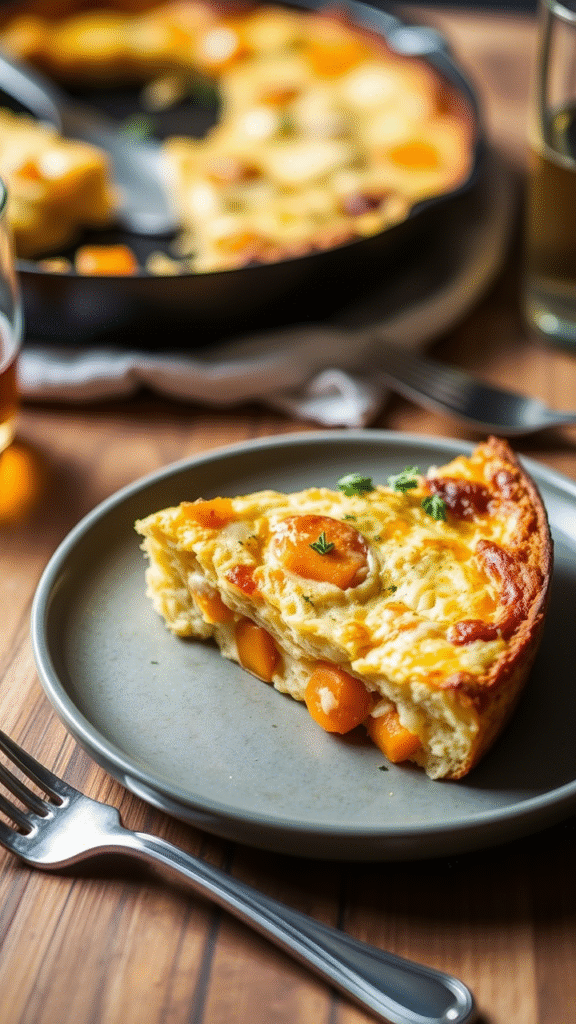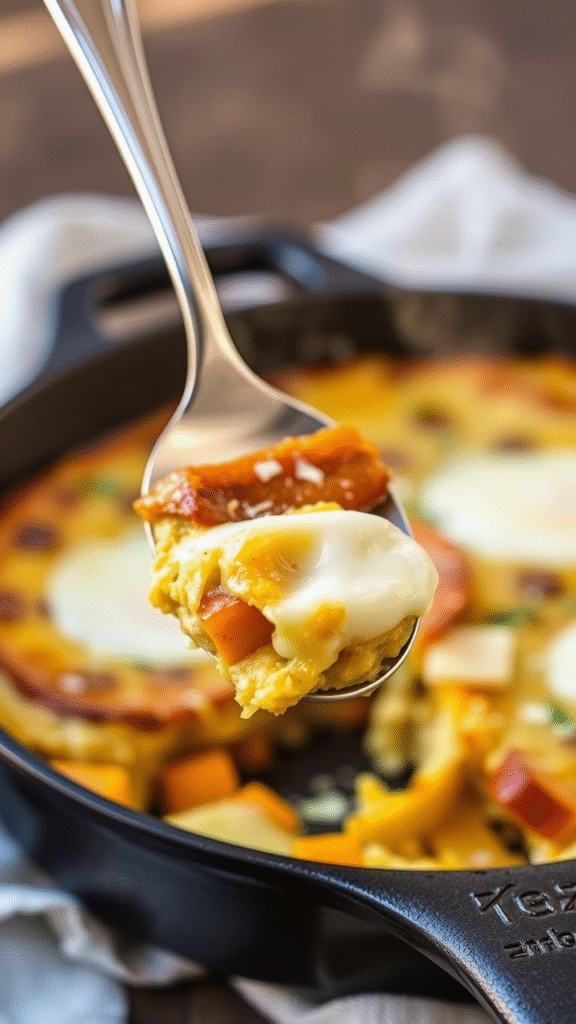Let me tell you something. The first time I made a butternut squash frittata, I botched it—burnt the bottom, forgot to salt the squash, used sad supermarket Parmesan. It was dry. It tasted like defeat. But the bones of it? Oh, the bones were good. Since then, this dish has been a sort of redemption arc. Now it’s one of those foolproof, Sunday-late-morning, glass-of-wine-in-hand, “trust me, you’ll love this” kinda things. Especially when that squash gets jammy, the eggs puff just right, and the Parmesan… well. You’ll see.
This ain’t just eggs and vegetables. It’s a velvet-textured frittata that bridges the warmth of roasted squash with the nutty backbone of Parmigiano-Reggiano. There’s a creamy-cheesy depth, a whisper of sage, and that slow-roasted sweetness that only butternut knows how to pull off.
And here’s why it matters: Frittatas are the culinary world’s sleeper hit. Understated. Versatile. Make-ahead friendly. This version? A bit rustic, deeply savory, and built for cooks who like to let ingredients show off. It’s got the bones of a classic, but the soul of fall in Tuscany.
Ingredients & Substitutions

Let’s start with the players. Use your eyes, nose, and fingers when selecting. Always.
- 1 medium butternut squash, peeled and cubed (about 3 cups)
Pro tip: Get one with a long neck—more usable flesh. Avoid pre-cut squash unless you’re in a real rush; it’s often dry and flavorless. - 2 tablespoons olive oil
Extra virgin? Sure. Just don’t use your super grassy, peppery one here. Keep it balanced. - Salt + cracked black pepper, to taste
Don’t eyeball salt if you’re unsure. Taste your squash after roasting. - 8 large eggs, preferably pasture-raised
Trust me, the yolks matter. Richer eggs make a richer frittata. - ½ cup heavy cream
You can use milk. But if you’re already in the kitchen, don’t be shy—cream makes it lush. - ¾ cup grated Parmigiano-Reggiano, plus extra for topping
Don’t use the shelf-stable shaker bottle, please. Real Parm or bust. If needed, swap with Grana Padano or aged Asiago. - 1 small shallot, thinly sliced
Red onion in a pinch. But shallot’s got that subtle bite—makes all the difference. - 1 clove garlic, minced
Optional—but it adds a warmth that blooms nicely in the fat. - ½ teaspoon fresh thyme leaves or finely chopped sage
Sage and butternut are best friends. Thyme is more floral, lighter—pick your vibe. - 1 tablespoon unsalted butter, for greasing the pan
Nonstick spray will betray you. Use butter and know your pan.
Optional extras:
- A pinch of chili flakes for heat
- A few spoonfuls of goat cheese or ricotta, dolloped before baking
- Handful of baby spinach, wilted before eggs go in
Step-by-Step Instructions
Alright. No messing about. Get your mise en place done first—this one moves fast once you start.
1. Roast the squash.
Toss cubes with olive oil, salt, pepper. Roast at 400°F (200°C) for about 25 minutes. They should be caramelized on the edges, just fork-tender. Not mushy.
Pro tip: Spread them out. Crowding steams them, and you lose that golden edge.
2. Prep your egg mixture.
Whisk eggs with cream, salt (½ tsp), pepper (a few cracks), and Parmesan. Set aside.
Common mistake: Overbeating the eggs. You want it homogenous, not frothy. Bubbles = spongey frittata.
3. Sauté aromatics.
In an ovenproof skillet (10-inch cast iron is king), heat a tablespoon of olive oil. Sauté shallot until translucent, about 2 mins. Add garlic and herbs, cook 30 seconds.
4. Combine.
Add roasted squash to the pan. Spread it out gently. Pour the egg mixture over, give the pan a little jiggle. Top with a little extra cheese if you’re smart.
5. Cook gently, then bake.
Let the frittata cook on the stovetop over medium-low for 2-3 minutes. Edges should begin to set. Transfer the pan to a 375°F (190°C) oven. Bake for 10-12 minutes, or until puffed and just set in the center.
Don’t overbake! The center should still wobble slightly. Residual heat will finish the job.
6. Rest and slice.
Let it cool 5–10 mins before slicing. Eggs tighten up. Flavors settle. You’ll thank yourself.
Cooking Techniques & Science

Here’s the nerdy bit (don’t skip this—it’s what separates line cooks from chefs).
Why roast the squash first?
Roasting caramelizes sugars via the Maillard reaction. It deepens flavor, removes moisture (which would otherwise dilute the eggs), and gives you that sweet-savory contrast.
Why finish in the oven?
Even cooking. If you try to cook the whole frittata on the stove, the bottom scorches while the top stays raw. The oven sets the custard gently.
Why add dairy to eggs?
Cream raises the coagulation temperature of eggs, giving you a softer, silkier texture. No cream? You’ll get a firmer bite, more like a Spanish tortilla.
The right pan matters.
A well-seasoned cast iron retains heat, gives that golden crust, and slides clean. Avoid glass or ceramic—uneven heat leads to soggy spots.
Salt timing is crucial.
Salt draws moisture. If you salt the eggs too early, they get watery. Salt the squash before roasting, then season the egg mixture right before you pour.
Serving & Pairing Suggestions
Serve it warm, not hot. Eggs don’t shine when they’re scalding.
Cut into wedges like a pie. Garnish with extra shaved Parm, fresh herbs, maybe a drizzle of chili oil or lemon zest if you’re feeling cheeky.
Pair it with:
- A bitter greens salad with Dijon vinaigrette
- Crusty sourdough, toasted and rubbed with garlic
- A dry white wine—Verdicchio, Pinot Bianco, or even a chilled orange wine if you dare
- For brunch: bitter espresso and a splash of blood orange juice
And leftovers? Unreasonably good. Cold or warm. Stack it on a baguette with arugula and aioli. Wrap it in foil, eat it on a hike. Or just straight from the fridge, like the savage you are.
What Makes This Frittata Special?

It’s the quiet kind of magic. No drama. Just really good texture, deeply balanced flavors, and a recipe that respects the ingredient.
Butternut squash is often relegated to soup. But here? It’s the star. Its sweetness against Parmesan’s salt. Its softness against the bite of shallot. And it carries the whole dish without shouting.
Plus, it’s adaptable. Vegetarian-friendly. Gluten-free. Elegant or rustic. You can plate it in wedges for a dinner party or wrap it up in parchment for a grab-and-go breakfast.
Final Tips & Variations
- Add pancetta or crisped prosciutto for a meaty edge
- Top with fried sage leaves for flair and crunch
- Bake in muffin tins for individual portions—15 mins at 375°F
- Use other squashes like kabocha or delicata—just roast a touch longer
- Fold in caramelized onions for a sweeter, denser base
Troubleshooting?
- Rubbery texture? Overbaked.
- Watery? Squash wasn’t roasted enough or too much milk.
- Bland? Salt. It’s not optional. Cheese isn’t enough.
FAQs
1. Can I make the frittata ahead of time?
Yes, it keeps beautifully. Store in the fridge up to 3 days. Reheat gently at 300°F, or eat cold.
2. What’s the best pan to use?
A 10-inch cast iron or oven-safe nonstick works best. Avoid stainless unless you like a wrestling match at cleanup time.
3. Can I freeze it?
Yep. Cool completely, slice, and wrap tightly. Reheat in foil, 325°F for 20–25 mins.
4. What if I don’t have Parmesan?
Try pecorino (saltier), aged gouda (nuttier), or even sharp cheddar for a twist.
5. Is this kid-friendly?
Totally. Skip the chili flakes, maybe mix in a bit of mozzarella to mellow the flavor.
In Closing
This isn’t just another frittata. It’s a masterclass in using humble ingredients well. It teaches balance—sweet against salty, soft against crisp, rich against light.
And most importantly, it reminds us: good food doesn’t need to be complicated. It just needs to be respected.

Food lover, recipe creator & the heart behind NoshCrafters.com. Olivia shares mouthwatering, easy-to-make dishes that turn everyday meals into unforgettable bites. When she’s not experimenting in the kitchen, she’s busy plating up inspiration for home cooks everywhere.